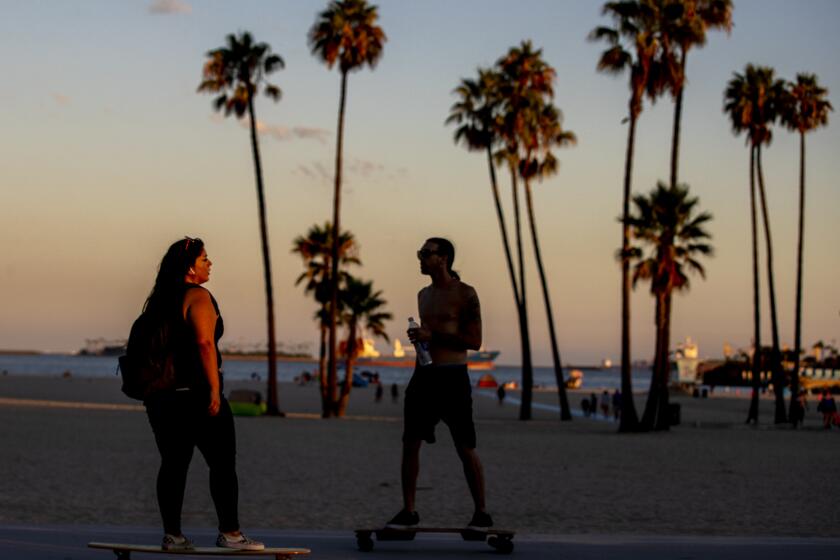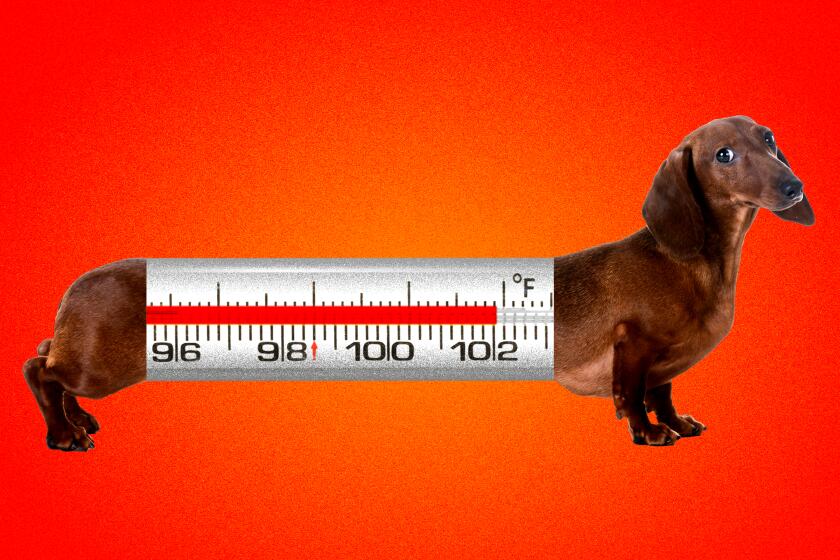How to stay safe during Southern California’s most intense heat wave

- Share via
Scorching temperatures are expected across Southern California this week as September brings in the longest and warmest heat wave so far this year.
Oppressive heat can increase the risk of heat-related illnesses. Here are some tips to avoid heat-related illnesses and to stay safe.
From Wednesday through Labor Day weekend, weather forecasters predict temperatures could reach as high as 115 degrees in some parts of Southern California.
Stay informed
You can monitor your area’s forecast by going to the National Weather Service’s website and searching by city, state or ZIP Code for the latest weather updates and alerts. Follow local officials and agencies on social media for tips and information on available resources in your area. Keep an extreme heat checklist to make sure you are prepared.
Stay indoors and dress in light clothing
Officials from the National Weather Service and public health offices advise people to stay indoors as much as possible, particularly between 10 a.m. and 3 p.m. when the sun is strongest. If you exercise outdoors, it’s recommended to do so early in the morning or later in the evening.
If you don’t have air conditioning, the Centers for Disease Control and Prevention recommends going to a mall or public library. You can also refer to your county’s website or call the local health department to learn about cooling centers in your area. Other options include taking a cool shower twice a day or even finding a shaded yard or park. (Health officials at UCLA say electric fans will not prevent heat-related illnesses when temperatures reach the high 90s and above.)
What you wear also matters. Officials suggest light-colored, lightweight, loose-fitting clothes when you are outdoors, along with a wide-brimmed hat. Be sure to use sunscreen with a protection factor of at least 15 and apply it about 30 minutes before going outside.
An excessive heat watch is in place for much of Southern California this week. Keep yourself, your kids and your pets safe during hot temperatures with these tips.
Watch out for heat-related illnesses
According to the CDC, heat-related illnesses can range from heat rashes and sun burns to more serious conditions including heat exhaustion and heat stroke, and result from the body’s inability to cool down by sweating. Signs of heat stroke, the most serious of the heat-related illnesses, include a temperature of 103 degrees or higher; hot, red, dry, or damp skin; fast, strong pulse; headache; dizziness; nausea; confusion and losing consciousness. If you’re experiencing these symptoms, seek immediate medical attention. The CDC advises against drinking anything and recommends moving to a cool place and into a cold bath or using a cold cloth.
Signs of heat exhaustion are heavy sweating; cold, pale and clammy skin; a fast, weak pulse; nausea or vomiting; muscle cramps; fatigue; dizziness; headaches; and fainting. If you’re showing these symptoms, get out of the sun immediately, seek a cool place or cool towels and sip water. Monitor your symptoms and get help if you are vomiting, the symptoms worsen, or they last longer than an hour.
Stay hydrated
Drinking plenty of fluids, particularly before going outdoors, is critical in preventing heat-related illnesses. Officials at UCLA warn against waiting until you’re thirsty to drink. During times of extreme heat, it’s best to drink at least two to four cups of water per hour. (For those working outside, the CDC suggests one cup of water, or 8 ounces, every 15–20 minutes.) Health officials also advise against drinking alcohol during times of extreme heat, as it causes dehydration and increases the risk of heat-related illnesses.
It’s also important to replenish the salt and minerals your body loses when it sweats by drinking low-sugar fruit juices or sports drinks. Dieticians also recommend eating foods with high water content — think watermelon, celery and cucumbers — along with drinking the right fluids.
Signs of dehydration in adults include extreme thirst; fatigue; dizziness; lightheadedness; dry mouth and/or lips, and infrequent urination. In infants or young children, look for dry mouths and tongues; no tears when crying; no wet diaper for more than three hours; sunken eyes and cheeks; a sunken soft spot on top of their head and irritability or listlessness.
(If your doctor has you on a particular diet, or regulates how much water you drink, ask about what steps you should take during heat waves to stay properly hydrated.)
If you think it’s hot outside, then your pet is definitely feeling it. Here are tips on how to keep your furry friends cool in the heat.
Check up on the most vulnerable
In addition to keeping yourself safe and healthy, check in frequently with those who are at high risk, including seniors, children, pregnant women, the unhoused, those who work outside and those without air conditioning. Heat also affects your pets, so keep them indoors or if they will be outside, make sure they have plenty of water and a shaded area to help them keep cool. Never leave a child or pet in the back seat of a car, as temperatures inside a vehicle can quickly skyrocket, even with windows cracked.
To help homeless people, the Los Angeles County Department of Public Health suggests donating water, electrolyte packages, light and loose-fitting clothing, tents, towels and other supplies to local organizations.
More to Read
Sign up for Essential California
The most important California stories and recommendations in your inbox every morning.
You may occasionally receive promotional content from the Los Angeles Times.














